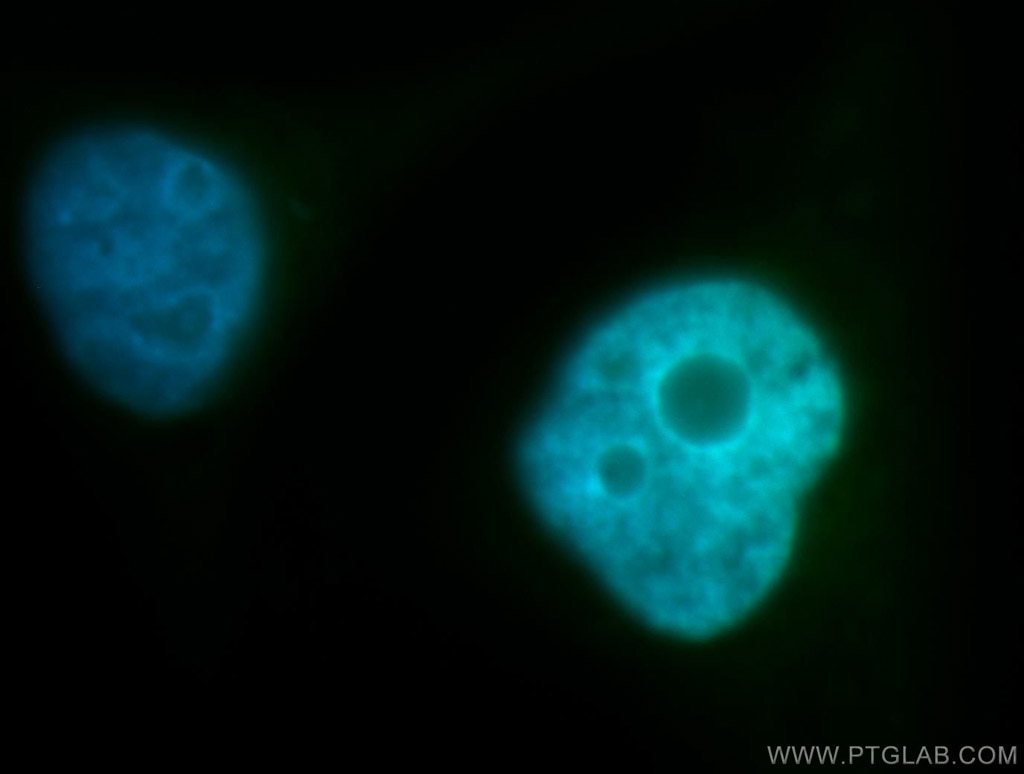BUB3 Polyklonaler Antikörper
BUB3 Polyklonal Antikörper für IF, ELISA
Wirt / Isotyp
Kaninchen / IgG
Getestete Reaktivität
human, Maus, Ratte
Anwendung
IF, ELISA
Konjugation
Unkonjugiert
Kat-Nr. : 10123-2-AP
Synonyme
Geprüfte Anwendungen
| Erfolgreiche Detektion in IF/ICC | HepG2-Zellen |
Empfohlene Verdünnung
| Anwendung | Verdünnung |
|---|---|
| Immunfluoreszenz (IF)/ICC | IF/ICC : 1:20-1:200 |
| It is recommended that this reagent should be titrated in each testing system to obtain optimal results. | |
| Sample-dependent, check data in validation data gallery | |
Produktinformation
10123-2-AP bindet in IF, ELISA BUB3 und zeigt Reaktivität mit human, Maus, Ratten
| Getestete Reaktivität | human, Maus, Ratte |
| Wirt / Isotyp | Kaninchen / IgG |
| Klonalität | Polyklonal |
| Typ | Antikörper |
| Immunogen | BUB3 fusion protein Ag0167 |
| Vollständiger Name | budding uninhibited by benzimidazoles 3 homolog (yeast) |
| Berechnetes Molekulargewicht | 37 kDa |
| GenBank-Zugangsnummer | BC005138 |
| Gene symbol | BUB3 |
| Gene ID (NCBI) | 9184 |
| Konjugation | Unkonjugiert |
| Form | Liquid |
| Reinigungsmethode | Antigen-Affinitätsreinigung |
| Lagerungspuffer | PBS with 0.02% sodium azide and 50% glycerol |
| Lagerungsbedingungen | Bei -20°C lagern. Nach dem Versand ein Jahr lang stabil Aliquotieren ist bei -20oC Lagerung nicht notwendig. 20ul Größen enthalten 0,1% BSA. |
Hintergrundinformationen
BUB3 is a conserved component of the mitotic spindle assembly complex and is an essential compent of spindle-assembly checkpoint (SAC) signaling that operates during early embryogenesis. BUB3 null embryos treated with a spindle-depolymerising agent fail to arrest in metaphase and show an increase in mitotic disarray. In mitosis, the SAC prevents anaphase onset until all chromosomes have been attached to the spindle microtubules and aligned correctly at the equatorial metaphase plate. BUB3 is involved in promoting the establishment of correct kinetochore-microtubule (K-MT) attachments in mammalian oocyte meiosis.
Protokolle
| PRODUKTSPEZIFISCHE PROTOKOLLE | |
|---|---|
| IF protocol for BUB3 antibody 10123-2-AP | Protokoll herunterladen |
| STANDARD-PROTOKOLLE | |
|---|---|
| Klicken Sie hier, um unsere Standardprotokolle anzuzeigen |


